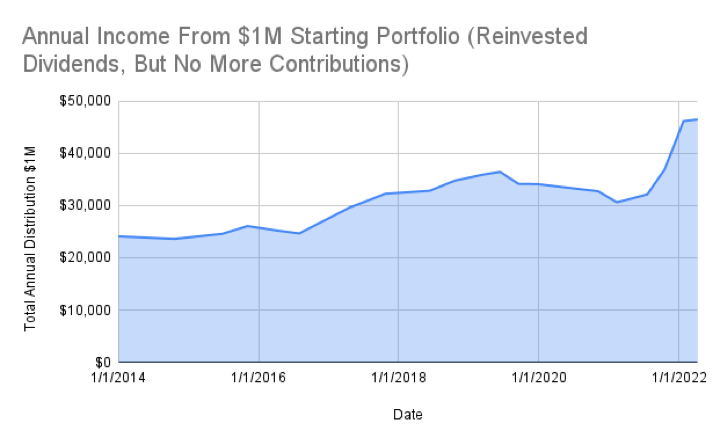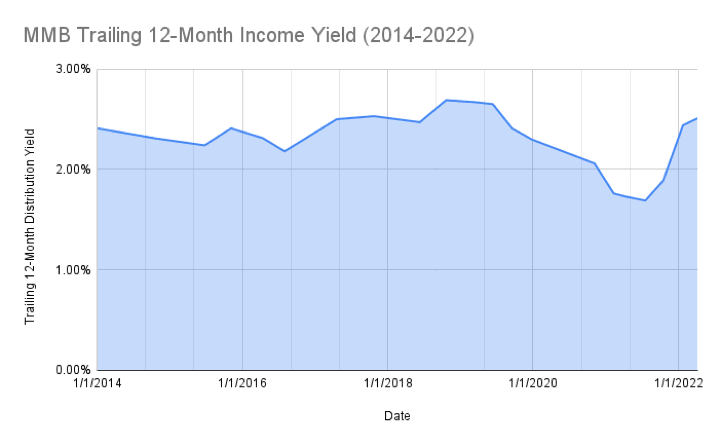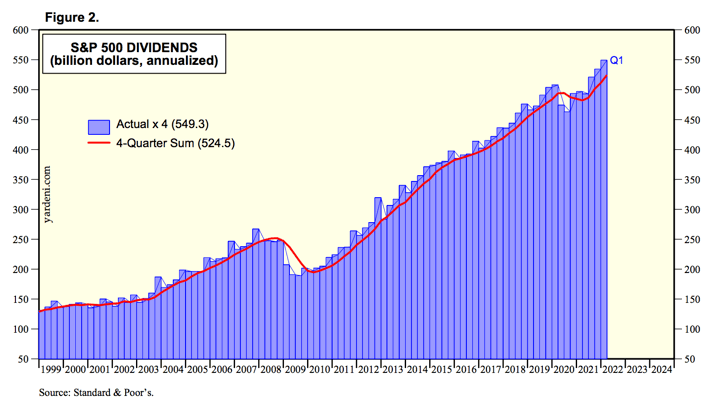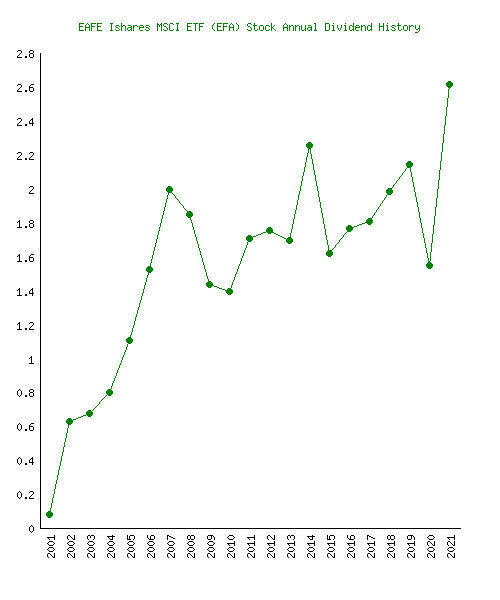Here’s a slightly-altered quarterly update on the income produced by my Humble Portfolio. I track the income produced as way to add a different view of performance. The total income goes up much more gradually and consistently than the number shown on brokerage statements (price), which helps encourage consistent investing. I imagine them as building up a factory that churns out dollar bills.
Annual income history. I started tracking the income from my portfolio in 2014. Here’s what the annual distributions from my portfolio look like over time:
- $1,000,000 invested in my portfolio as of January 2014 would have generated about $24,000 in annual income over the previous 12 months. (2.4% starting yield)
- If I reinvested the income but added no other contributions, today in 2022 it would have generated ~$46,000 in annual income over the previous 12 months.
- If I spent every penny of the income every single year instead, today in 2022 it would still have generated ~$36,000 in annual income over the previous 12 months.
This chart shows how the annual income generated by my portfolio has changed.

TTM income yield. To estimate the income from my portfolio, I use the weighted “TTM” or “12-Month Yield” from Morningstar, which is the sum of the trailing 12 months of interest and dividend payments divided by the last month’s ending share price (NAV) plus any capital gains distributed (usually zero for index funds) over the same period. The trailing income yield for this quarter was 2.51%, as calculated below. Then I multiply by the current balance from my brokerage statements to get the total income.

| Asset Class / Fund | % of Portfolio | Trailing 12-Month Yield | Yield Contribution |
| US Total Stock (VTI) | 25% | 1.30% | 0.33% |
| US Small Value (VBR) | 5% | 1.77% | 0.09% |
| Int’l Total Stock (VXUS) | 25% | 3.21% | 0.80% |
| Emerging Markets (VWO) | 5% | 2.96% | 0.15% |
| US Real Estate (VNQ) | 6% | 2.78% | 0.17% |
| Inter-Term US Treasury Bonds (VGIT) | 17% | 1.19% | 0.20% |
| Inflation-Linked Treasury Bonds (VTIP) | 17% | 4.52% | 0.77% |
| Totals | 100% | 2.51% |
Stock market dividend growth over time. Stock dividends are a portion of profits that businesses have decided they don’t need to reinvest into their business. The dividends may suffer some short-term drops, but over the long run they have grown faster than inflation. The ratio of dividend payouts to price also serve as a rough valuation metric. When stock prices drop, this percentage metric usually goes up – which makes me feel better in a bear market. When stock prices go up, this percentage metric usually goes down, which keeps me from getting too euphoric during a bull market.
Here’s a related quote from Jack Bogle (source):
The true investor will do better if he forgets about the stock market and pays attention to his dividend returns and to the operating results of his companies.
If you retired back in 2014 and have been living off your stock/bond portfolio, your total income distributions are much higher in 2022 than in 2014. Here is the historical growth of the S&P 500 total dividend, which tracks roughly the largest 500 stocks in the US, updated as of Q1 2022 (via Yardeni Research):

This means that if you owned enough of the S&P 500 to produce an annual dividend income of about $26,000 a year in 1999, then today those same shares would be worth a lot more AND your annual dividend income would have increased to over $100,000 a year, even if you had spent every penny of dividend income every year!
Here is the historical growth of the total dividend of the EAFE iShares MSCI ETF, which tracks a broad index of developed non-US stocks (VXUS is a newer ETF), via Netcials.

European corporate culture seems to encourage paying out a higher percentage of earnings as dividends, but is also more forgiving of adjusting the dividends up and down with earnings. US corporate culture tends to be more conservative, with the expectation that dividends will be growing or at least stable. This is not true across every company, just a general observation.
Use as a retirement planning metric. It’s true that during the accumulation stage, your time is better spent focusing on earning potential via better career moves, improving in your skillset, and/or looking for entrepreneurial opportunities where you can have an ownership interest. As an overall numerical goal, I support the simple 4% or 3% rule of thumb, which equates to a target of accumulating roughly 25 to 30 times your annual expenses. I would lean towards a 3% withdrawal rate if you want to retire young (before age 50) and a 4% withdrawal rate if retiring at a more traditional age (closer to 65).
However, I find that tracking income makes more tangible sense in my mind and is more useful for those who aren’t looking for a traditional retirement. Our dividends and interest income are not automatically reinvested. They are another “paycheck”. Then, as with a traditional paycheck, we can choose to either spend it or invest it again to compound things more quickly. Even if we spend the dividends, this portfolio paycheck will still grow over time. You could use this money to cut back working hours, pursue a different career path, start a new business, take a sabbatical, perform charity or volunteer work, and so on. This is your one life and it only lasts about 4,000 weeks.
 The Best Credit Card Bonus Offers – 2025
The Best Credit Card Bonus Offers – 2025 Big List of Free Stocks from Brokerage Apps
Big List of Free Stocks from Brokerage Apps Best Interest Rates on Cash - 2025
Best Interest Rates on Cash - 2025 Free Credit Scores x 3 + Free Credit Monitoring
Free Credit Scores x 3 + Free Credit Monitoring Best No Fee 0% APR Balance Transfer Offers
Best No Fee 0% APR Balance Transfer Offers Little-Known Cellular Data Plans That Can Save Big Money
Little-Known Cellular Data Plans That Can Save Big Money How To Haggle Your Cable or Direct TV Bill
How To Haggle Your Cable or Direct TV Bill Big List of Free Consumer Data Reports (Credit, Rent, Work)
Big List of Free Consumer Data Reports (Credit, Rent, Work)
Do you have actual real estate rental units?
Nope, I respect the real estate game but it doesn’t suit my personality nor my desire for a hassle-free retirement. I’m content with my REITs.